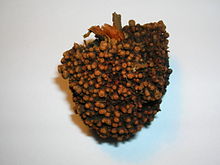
Back فرانكيا (جنس من بدائيات النوى) ARZ Frankia Catalan Frankia Danish Frankia English Frankia Spanish Frankia Estonian Frankia French Frankia (genus) ID Frankia Italian フランキア属 Japanese
| Frankia | |||||||||||
|---|---|---|---|---|---|---|---|---|---|---|---|
 Nódulo radicular de amieiro onde se poden encontrar as Frankia. | |||||||||||
| Clasificación científica | |||||||||||
| |||||||||||
| Especie tipo | |||||||||||
| Frankia alni (Woronin 1866) Von Tubeuf 1895 | |||||||||||
| Especies[5] | |||||||||||
| |||||||||||
| Sinonimia | |||||||||||
Frankia é un xénero de bacterias fixadoras do niutróxeno que viven en simbiose con plantas actinorrícicas, similar ás bacterias Rhizobium atopadas nos nódulos radiculares de legumes da familia Fabaceae. Frankia tamén inicia a formación de nódulos radiculares.
Este xénero foi nomeado orixinalmente por Jørgen Brunchorst en 1886 en honra do biólogo alemán Albert Bernhard Frank.[6] Brunchorst considerou que o organismo que identificara era un fungo filamentoso. Jan-Hendrik Becking redefiniu o xénero en 1970 como de bacterias actinomicetas e creou para el a familia Frankiaceae dentro da orde Actinomycetales (hoxe na orde Frankiales). Mantivo o nome orixinal de Frankia para o xénero.[7] Polo momento Frankia é o único xénero validamente publicado da familia Frankiaceae.[8]

- ↑ Becking JH. (1970). "Frankiaceae fam. nov. (Actinomycetales) with one new combination and six new species of the genus Frankia Brunchorst 1886, 174". International Journal of Systematic Bacteriology 20: 201–220. doi:10.1099/00207713-20-2-201.
- ↑ Brunchorst J. (1886). "Über einige Wurzelanschwellungen, besonders diejenigen von Alnus und den Elaegnaceen" [On root swellings, particularly those of Alnus and the Elaeagnaceae]. Untersuchungen aus dem botanischen Institut in Tübingen [Investigations of the Botanical Institute in Tübingen ] 2 (151–177).
- ↑ Normand P; Nguyen, T.V.; Battenberg, K; Berry, A.M.; Heuvel, B.V.; Fernandez, M.P.; Pawlowski, K. (2017). "Proposal of "Candidatus Frankia californiensis", the uncultured symbiont in nitrogen-fixing root nodules of a phylogenetically broad group of hosts endemic to western North America". Int J Syst Evol Microbiol 67 (10): 3706–3715. PMID 28884663. doi:10.1099/ijsem.0.002147.
- ↑ Normand, P; Nouioui, I; Pujic, P; Fournier, P; Dubost, A; Schwob, G; Klenk, HP; Nguyen, A; Abrouk, D; Herrera-Belaroussi, A; Pothier, J.F.; Pflüger, V; Fernandez, M.P. (2018). "Frankia canadensis sp. nov., isolated from root nodules of Alnus incana subspecies rugosa". Int J Syst Evol Microbiol 68 (9): 3001–3011. PMID 30059001. doi:10.1099/ijsem.0.002939.
- ↑ Euzéby, J.P.; Parte, A.C. "Frankia". List of Prokaryotic names with Standing in Nomenclature (LPSN). Consultado o 16 de xuño de 2021.
- ↑ Pawlowski, Katharina (2009-06-17). Prokaryotic Symbionts in Plants. Springer Science & Business Media. p. 107. ISBN 9783540754602.
- ↑ "Frankia taxonomy". Arquivado dende o orixinal o 2011-07-27. Consultado o 2011-01-14.
- ↑ LPSN Frankiaceae